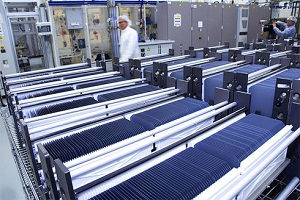Week in review: Is solar starting to resurge?
 The rate of solar installations continues to go up and appears to be increasing more rapidly than in the past. Still solar manufacturing has lagged as manufacturers have had a backlog of modules for a while. But some manufacturers are now looking at ramping up production once again. A lot of this is due to more demand from the Asian market.
The rate of solar installations continues to go up and appears to be increasing more rapidly than in the past. Still solar manufacturing has lagged as manufacturers have had a backlog of modules for a while. But some manufacturers are now looking at ramping up production once again. A lot of this is due to more demand from the Asian market.
First off, a new Ernst & Young report out last week showed that renewable energy—primarily wind and solar in the U.S. accounted for nearly 50 percent of all new energy generation capacity in the first half of 2012. The report found that the U.S. installed 3,313 megawatts of solar and 13,124 megawatts of wind power in 2012. It also showed a lower investment in the technologies as the price of solar has come down.
But the U.S. isn’t even leading the way in terms of newly installed solar. That would be Asia this year. China and Japan are anticipated to install 9 gigawatts of solar in the second half of 2013. And the whole Asia Pacific region will install 16 gigawatts in the second half of 2013 that’s about 40 percent of all the world’s new PV, according to a new NPD Solarbuzz report.
However, one spot in Asia, India, might not be so hot for solar in the second half of the year. The world’s second-most populous country has seen a recent explosion in solar, growing from 190 megawatts of installed solar in 2011 to more than 1.8 gigawatts of solar installed today. But as the country is investigating imposing anti-dumping and domestic content requirements the solar industry is taking a wait and see approach, according to a new report from Mercom Capital Group.
PV manufacturers have long bared the brunt of the solar industry’s woes. As demand increased many announced plans to expand quickly to meet future demand...then demand was outpaced by supply, causing module prices to drop significantly. Now, at least a few PV manufacturers are again experiencing demand that tests their current manufacturing capabilities. Among them, Trina Solar, SunPower and JinkoSolar. Trina has said it may even expand manufacturing as soon as 2014.
China finally retaliated against U.S. tariffs imposed on Chinese PV imports by imposing a tariff on U.S. polysilicon producers. The tariffs will range from 2.4 percent to 57 percent. The U.S. has been a major supplier of polysilicon to Chinese PV manufacturers, but by imposing costly, restrictive tariffs on the material, the Chinese manufacturers may start looking elsewhere to supply their polysilicon needs.




